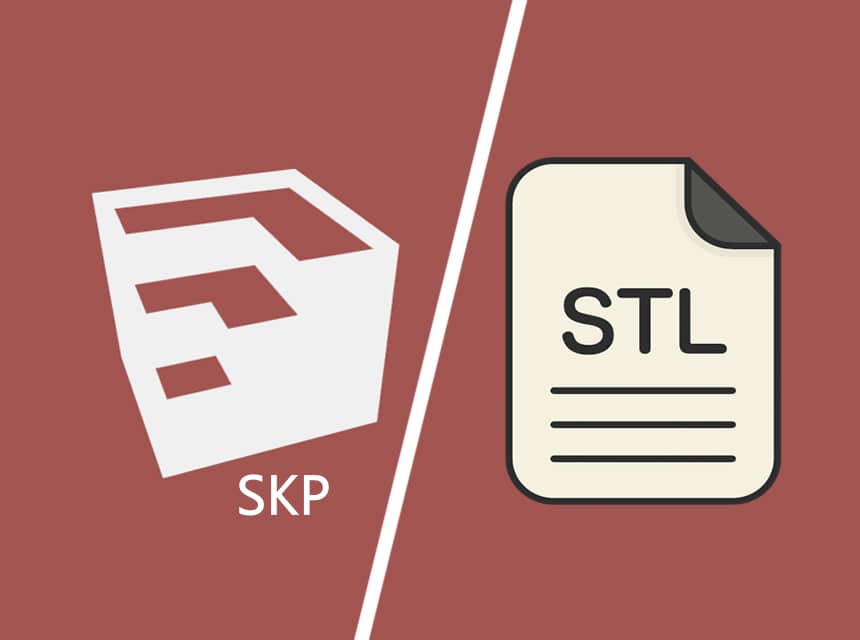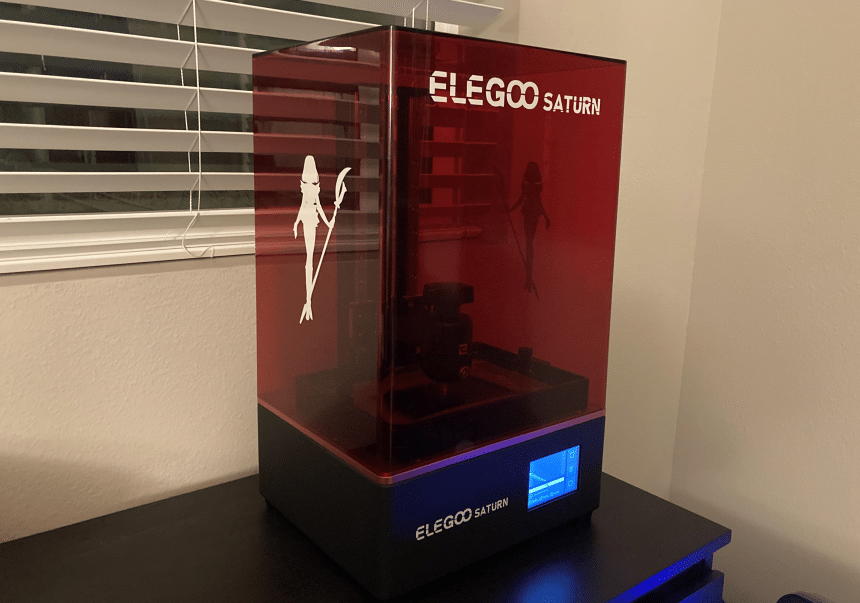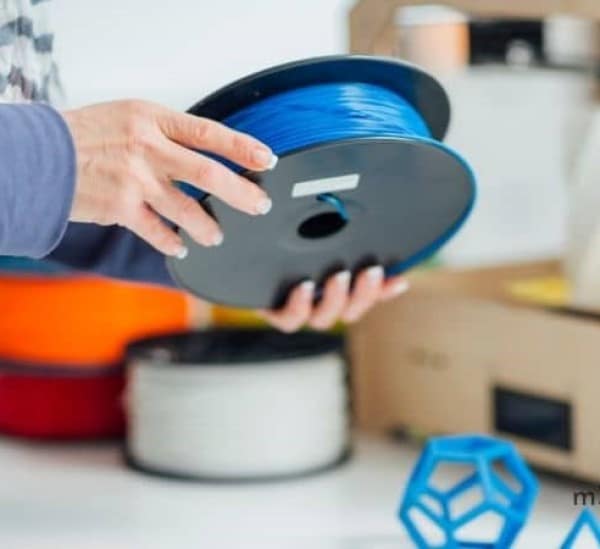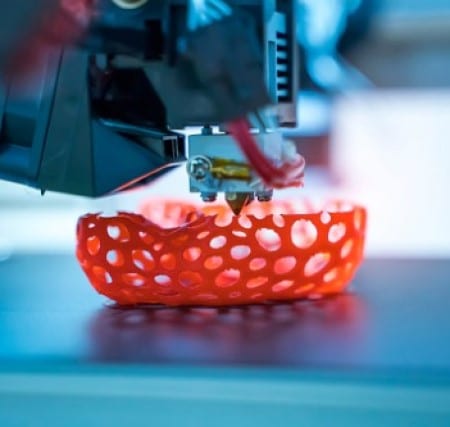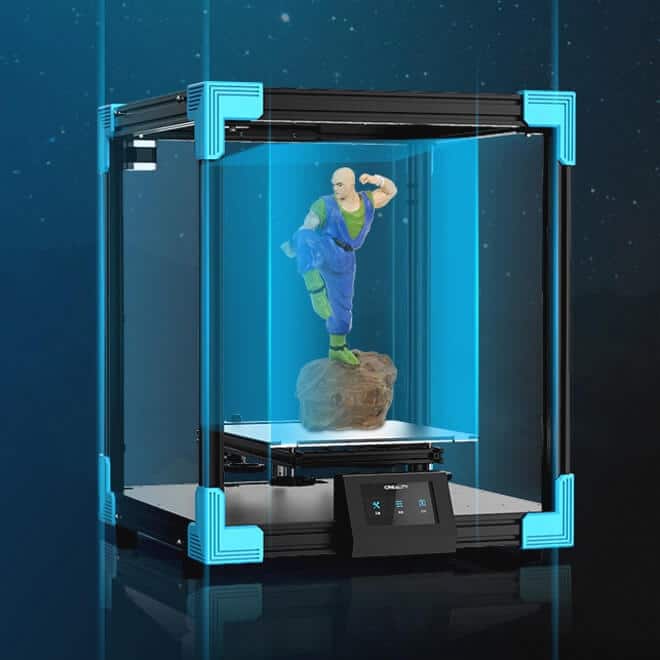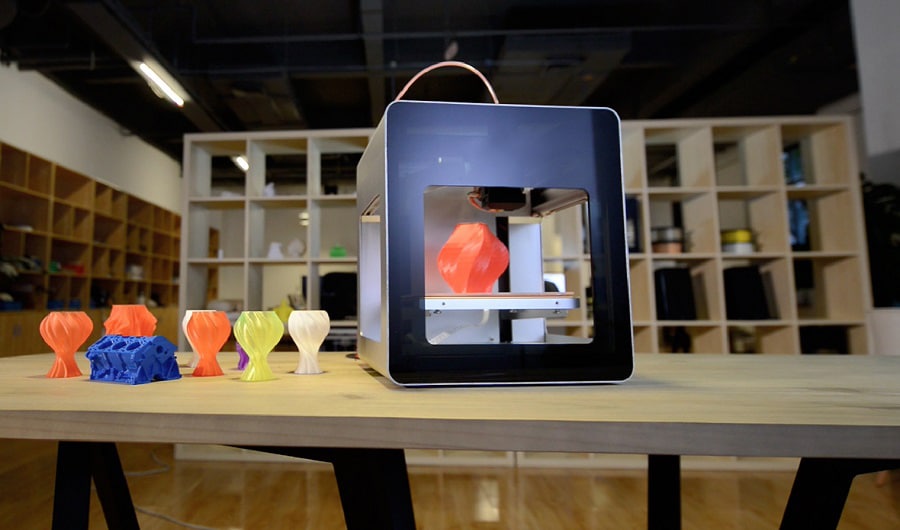

Did you know that the CoreXY design is just a concept, not an implementation? Manufacturers come up with specific plans to implement CoreXY. Since their invention, CoreXY printers remain the fastest, most distinctive, and most versatile 3D printers on the market. They have gained notoriety among hobbyists and professionals because of their fast speeds, high accuracy, and stability. With all the available options, choosing a CoreXY 3D printer can be hard, especially if you are new to 3D printing.
We have created a list of the 10 best CoreXY 3D printers with the top Formbot Voron 2.4 R2 CoreXY 3D Printer Kit to help you easily get what suits your needs. We reviewed 25 products and made a list of 10 by considering crucial features like print speed, build volume, print resolution, print size, and filament compatibility, among others. The features determine the printers’ ease of use, efficiency, and performance. Read on to see if we have what you are looking for.
The Voron 2.4 scoops the top spot on our list because it is the most popular and versatile CoreXY 3D Printer on the market. It is one of the five popular printers that are a part of the 2015 Voron initiative. All Voron printers come as a kit, and the Voron 2.4 is no exception. The kit includes an all-metal titanium alloy print head with a direct drive extruder so you can print with various materials. It also features Moon’s stepper motors for high reliability and PEI magnetic build plate for easy print removal. The components of the Printer’s kit allow you to build the Printer to your liking.
The Voron 2.4 is the fourth version of the Voron 2.0 and is the most complex of all the Voron machines. It compares favorably to the previous Voron versions, like the Voron 1.8, with unique features like a 4-point gantry tramming for aligning the print surface and Dual MCUs. It is also the largest Printer in the Voron family, thus, the most expensive. A unique thing about the Voron 2.4 kit is an all-belt system even on its Z-axis, which makes bed leveling super-easy. Although it is the mother of all CoreXY printers, Voron 2.4 is a bit more challenging to build because of its engineering sophistication and complexity.
The Vivedino Troodon CoreXY 3D Printer is our second bet pick because it has a top-tier specs sheet, typical of a premium CoreXY 3D printer. The Printer comes pre-assembled, and you can choose from the two build volumes offered. The Printer’s impressive spec sheet includes a direct drive extruder and a magnetic PEI flexible build plate that is compatible with various printing materials. You also get a 32-bit motherboard, an automatic bed-leveling probe, a TMC2660 stepper driver, and a HEPA filter for filtering out 3D printer fumes. To top it all, you are guaranteed great printing precision with the all-belt-driven motion system and precision linear rails.
The Vivedino Troodon CoreXY 3D Printer is similar to the popular Voron 2.4 above. They have virtually similar specs, including the PEI flexible build plate and a direct driver extruder. The primary difference between the two premium printers is that the Vivedino Troodon comes pre-assembled. Moreover, it is a premium option with a matching price tag. If you are a beginner in 3D printing or an amateur, you may want to look elsewhere. Professionals who consistently produce high-quality prints would make the most of this Printer.
The Tronxy X5SA-500-2E is another top-quality printer with a ton of user-friendly features. It comes with a Titan extruder, which is compatible with various filaments, including PLA, HIPS, ABS, PVC, and wood, among others. Its X/Y axis adjustable tension belts provide excellent precision, so you can easily achieve the best print results. Best of all, the Printer comes with an OSG external dual-axis guide that gives it a long service life and allows you to achieve industrial-level precision. Other convenient features that make the Printer a joy to use are filament run-out detection and resume print function.
The Tronxy X5SA-500-2E has a lot in common with the Tronxy X5SA. Both printers have identical features and can print a wide range of models like sculptures, ornaments, gadgets, and other functional tools with different printing materials. The only difference between them is that the Tronxy X5SA-500-2E is upgraded with a guard rail and titan extruder that allows a smoother movement of the print bed. Both printers are primarily targeted toward students and hobbyists. You wouldn’t go wrong with either Printer as a beginner, but the Tronxy X5SA-500-2E is slightly pricier than the Tronxy X5SA.
It is hard to discuss 3D printers without mentioning Creality. The Chinese brand needs no introduction as they are widely known for top-of-the-line models that offer cutting-edge technology. The Creality CR-30 3D Printer is a unique printer with game-changing features. Unlike many consumer 3D printing machines, the printer prints on a conveyor belt which allows the machine to print parts in a serial manner that is ideal for production parts. Further, its 3DPrintMill is outfitted with a high-performance nozzle kit that allows continuous printing along the horizontal Z-axis. The Printer’s hot end is set to 45 degrees to print indefinitely. You will appreciate the FDM technology and high precision of up to 400 microns.
The Creality CR-30 3D Printer is a perfect productive mini-factory printer like the premium Voron 2.4 and Vivedino Troodon. The only difference is that it has the ability to print infinitely as it prints on the rolling conveyor belt instead of a print bed. You can print large objects on the Z-axis or smaller parts on the production line. Moreover, Creality has an exclusive printing software, ‘Creality Belt,’ which is specially designed for unlimited printers. If you are a hobbyist or DIYer into making production parts, the Creality CR-30 is your prime pick as it is capable of printing for 200 hours continuously.
We couldn’t get enough of Tronxy. The D01 PLUS GUARD CoreXY 3D Printer is a relatively affordable CoreXY 3D printer with exceptional features and performance. It boasts a sleek yet rugged design with a full metal structure and a transparent bottom. Its printing platform is covered by a special porous coating that provides excellent adhesion. Removing objects from the platform is equally easy. Once it cools down, you can grab the objects with your bare hands or use a scrapper to remove larger objects. Most importantly, the Printer features an OSG external dual-axis guide that guarantees high printing precision, smoothness, and high wear resistance. Its building size is also decent, coming in at 330mm x 330mm x 400mm.
The D01 PLUS GUARD CoreXY 3D Printer is stacked up against other solid CoreXY 3D printers like Vivedino Troodon and Voron 2.4, yet it has a fairer price point. It compares favorably against the Tronxy X5SA and Tronlxy X5SA-500-2E as it has more advanced features and better performance. The Printer is ideal for an experienced professional looking who is not ready to dent their wallet. The main downside is that the Printer needs assembly, though the manufacturer completes the hardest assembly process to give you an easy time.
The Creality Ender 6 is one of Creality’s high-quality printers with top value for money. It is also one of Creality’s attempts at CoreXY. It combines the features and top performance of the famous Ender 3D printers with the benefits of CoreXY. The Ender 6 has a fully enclosed design and a decently large build volume of 250 x 250 x 400mm. It is incredibly easy to use thanks to the myriad of convenient features like power resume print function, filament run-out detection, and a touch screen with an updated user interface. The only thing you will not like about the Ender 6 is the manual bed leveling. Considering the large bed size, the bed leveling will be tedious, but you can make your life easier with a leveling sensor.
The Creality Ender 6 is a perfect beginner-friendly CoreXY 3D printer like the Tronxy X5SA on this list. It comes partially pre-assembled, so you can easily put it together even if you don’t have technical skills. It has all the basic features you would need for a high-quality print and a decent bed size. Also, unlike the Tronxy X5A and many CoreXY 3D printers, you can use it in the classroom or home setup without worrying about safety, thanks to its fully enclosed design. Moreover, you do not have to break the bank, as it is reasonably priced.
The Tronxy X5SA-400 2E 3D Printer is the ultimate CoreXY 3D Printer for commercial use. Besides its massive printing size of 400 x 400 x 400mm, the Printer packs a punch with multiple cool features. For starters, the Printer features a double titan extruder which makes it compatible with various filaments, including; PLA, PETG, WOOD, TPU, and ABS. It also has an industrial–grade high-quality Z-axis screw that ensures accurate positioning for a great printing experience. Its motherboard has an ultra-quiet driver chip which minimizes noise during printing. Moreover, using the Printer is such a breeze, thanks to the full-color touch screen with a simple user interface.
Like all Tronxy printers, the X5SA-400 2E 3D Printer has convenient features like a power resume function, automatic bed leveling, and filament run-out detection. Except for its printing size, the X5SA-400 2E 3D Printer is pretty similar to all the Tronxy printers on this list. Also, because of its larger printing size, it is pricier and better suited for experienced professionals looking to produce high-quality prints for commercial purposes. The best thing about the Printer is that despite having a large printing size, it is incredibly easy to use, that even beginners can wrap their heads around its operation in no time.
Many CoreXY 3D printers have significant build volumes to take advantage of the fast printing speeds provided by the CoreXY design. The Voron 0.1 is an exception. It has a relatively small build volume of 120x120x120mm, which you can only use to print small objects. The compact build makes the Voron 0.1 one of the best CoreXY printers you can get if you have a small or cramped up workstation. You can set up the perfect mini-factory on your desk. Despite having a small build volume, the Voron 0.1 is still a beast with top-of-the-line features like an all-metal titanium print head that makes it compatible with various printing materials. Its adjustable magnetic PEI printing bed allows for easy removal of prints. The Printer’s z-axis features a lead screw for its bed’s movement, and the X and Y axes are belt driven.
The Voron 0.1 is as good as most premium CoreXY 3D printers out there, including the Voron 2.4. For a beginner, the Voron 0.1 is a prime option as it will allow you to experiment with exotic print materials. You can advance to the more premium and complex Voron 2.4 once you become a professional. It is also a perfect choice for any prosumer or professional in need of a small build volume. However, if you want the best bang for your buck with a beginner budget, the Tronxy X5SA is a better bet.
The Creality 3D Ender-4 3D is another one of Creality’s CoreXY 3D printers with a great price and performance balance. It is the perfect compact Printer you need for your narrow or cramped up workstation. The Printer has a pretty decent build volume of 220 x 220 x 300 mm. Unlike many affordable 3D printers, the Ender 4 has a heated printing bed and automatic leveling. The heated aluminum bed is compatible with various filaments, including PLA, TPU, ABS, Wood, Copper, and Carbon Fiber. Typical of Creality, the Ender 4 has a couple of convenient features, like a filament monitoring alarm system and an LCD display for easy control. The filament monitoring alarm system will detect if you are low on the filament and alert you early so your project is not interrupted.
The Creality 3D Ender-4 3D doesn’t compare favorably with the more popular Ender 6 because the latter has more advanced features. Also, the Ender 4 requires a lot of tweaking for you to achieve high-quality printing results. However, it stacks up well against hobbyist and DIY printers like the Voron 0.1 and Tronxy X5SA. It is a robust and super-accurate printer that offers better value for money than its premium, compact peers like the Voron 0.1.
The Tronxy X5SA is a CoreXY 3D printer kit with superior features. Its build volume is impressive for its price point, coming in at 330 x 330 x 400 mm. Its Bowden-style extruder ensures you have the fastest printing speeds. The filament run-out detection, auto-bed leveling system, and resume print function make it an incredibly convenient printer that anyone can easily use. As if all that’s enough, the Printer features a coated glass bed and a 3.5-inch touchscreen for maximum user convenience during the 3D printing process.
The Tronxy X5SA is a CoreXY 3D printer kit like the Voron 2.4. Although it is a fantastic choice, the Voron 2.4 is more complex and premium. It is perfect for 3D printing beginners looking for a significant build volume on a budget or students. Its print quality is also exceptional for its price point. Moreover, it has plenty of features that make it super-easy to use, like a resume print function and an auto-bed leveling system. The Voron 2.4 does not even come pre-assembled, thus is better suited to 3D printing professionals who love DIY.
Choosing a CoreXY 3D printer from the multiple options in the market can be a daunting experience, especially if you have no clue what to look for. This section has everything you need to know when choosing a CoreXY 3D printer to make the best buy.
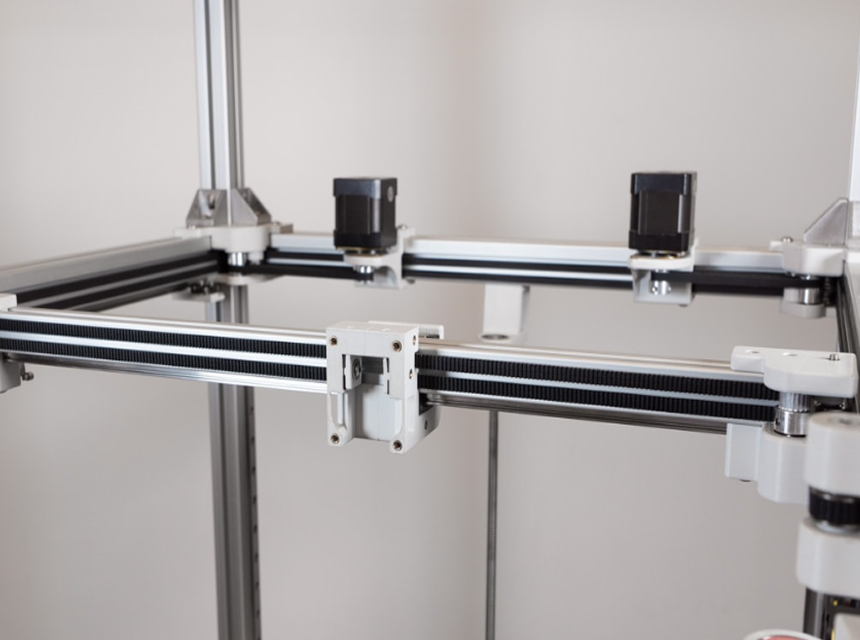
CoreXY printers got their name from the fact that their heads only move on the X and Y axes. Their base moves along the Z-axis to create a 3D structure. According to Ilan E Moyer, the creator of CoreXY, it is more of a concept than an implementation. He defines CoreXY as a technique designed to help you build new tools that are as unique as your ideas.
Essentially, CoreXY printers have a motion system of belts and pulleys that move the printer head on the XY plane. Stepper motors move the belts to position the printhead. The printbed is mounted on a Z-axis motion system that moves it up and down so that the printhead can print layers for the desired part of the piece.
CoreXY design comes with significant benefits like top printing speeds and high precision. Most CoreXY machines feature a square enclosure to allow free movement and a base that moves up and down freely. Premium models have glass sides that act as a safety barrier and trap fumes.
CoreXY 3D printers use FDM printing, which according to HUBS, is the most popular printing technology. It is the most widely used printing technology because it is relatively easy to master and creates durable products quickly and reliably. FDM printing uses filament to create structures and builds parts layer by layer by depositing melted material in a predetermined path selectively.
CoreXY printers are often confused with their H-bot counterparts. They have a lot in common, but CoreXY’s belt system is different. It allows less torque and fewer vibrations. You have to be super-keen when buying a CoreXY printer, as many H-bot models are mislabeled and falsely advertised as CoreXY printers.
Faster printing speeds: CoreXY printers are faster than other printers because their printing heads don’t move in all three axes.
Low-maintenance: The machines have better longevity and are low-maintenance because they only move in two axes and thus require just a few parts.
Perfect for small, high-precision printing: CoreXY printers allow you to scale down your designs to get more precise details.
Affordable: You may pay more when buying filaments, but CoreXY printers are more affordable than other higher-end models.
Complex assembly process: You can escape the complicated assembly process of a CoreXY 3D printer by buying a pre-assembled model. However, you would have to dig deeper into your pockets. The Kits are more affordable but require some technical know-how for proper fine-tuning.
Inconvenient vibrations: When the pad moves during printing, the machine wobble and vibrates slightly, causing small imperfections in your finished models.
Belt tuning and maintenance: CoreXY 3D printers generally require little maintenance but models with belts like Creality CR-30 require belt maintenance. You can get disastrous results if you fail to align the belts properly.
Some of the crucial parameters you must consider when choosing a CoreXY 3D printer are;
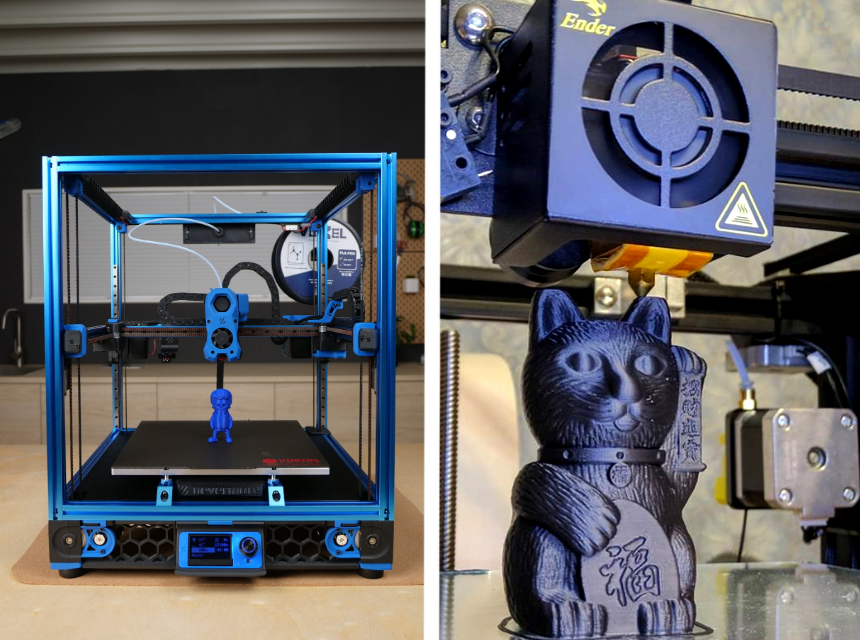
CoreXY 3D printers make the most out of their build volume. Most of them have larger build volumes than the standard Cartesian models, and with the CoreXY design, they take full advantage of the fast printing speeds. The footprint of a CoreXY printer and its build volume is almost similar.
You should choose a build volume that suits what you want to use the Printer for. If you want to print large objects at a fast speed, consider a model like the Formbot Voron 2.4 R2 CoreXY 3D Printer Kit. It has significant print volume, speed, and accuracy. On the other hand, models like Voron 0.1 and Creality Ender 4 are excellent options if you need to print small objects at a fast speed.
The ultimate, most versatile build volume that will give you excellent value for money is 300x300x300mm.
CoreXY printers have a higher printing speed than their Cartesian counterparts. A typical CoreXY printer can print at a top speed of up to 150mm/s, and you can adjust it to get higher speeds of up to 250mm/s or more. Cartesian printers can only print as fast as 90 to 100mm/s without compromising print quality.
Faster printing speeds are super-convenient as you get to save on electricity costs because of the lesser duration of prints. You also get to enjoy and quicker production cycle as you can re-iterate your designs faster without compromising on print quality or accuracy.
Formlabs defines print resolution as the print quality of a 3D printer based on the print’s nozzle size and layer height. If you print and a high layer height with a large nozzle, you get a reduced print resolution and poorer print quality. Small nozzle size and lower layer height results in a higher print resolution and quality.
The standard nozzle size for most CoreXY printers is 0.4mm, which allows you to print at layers heights of 0.12mm and 0.28 mm. You are likely to get better-looking prints with high resolution from a compact CoreXY 3D printer like the Voron 0.1 because of its small, sturdy, and rigid frame. The Voron 0.1 can print at a layer height of 0.5mm, which is among the industry’s highest print resolutions.
If you need the best print quality and a decent build volume, the Creality Ender 6 and Voron 2.4 are your best bets.
Not all 3D printers can print on a big scale. Many cheap models can only print small objects of up to 11 cm. Mid-priced and premium models have enough room for objects with edge lengths of up to 30 cm. The printer’s build volume, the printing bed, the extruder, and the guidance mechanism determine the maximum print size.
Another perk of CoreXY design is how easy it is to enclose the 3D Printer with panels on all sides to be able to print temperature-sensitive materials like Nylon, PETG, and ABS. Besides an enclosed design, most CoreXY 3D printers come with a heated bed and a hot end that can go up to 260 degrees Celsius, thus highly compatible with various printing materials, including PLA, ABS, Nylon, and PETG.
Premium CoreXY 3D printers like Voron 2.4 have high-end hot ends like the famous Phaetus Dragon hot end that can heat up to 500 degrees Celsius, so you can work with the most advanced printing materials like PolyCarbonate, PEI, PEEK, and PolyPropylene. These materials should be enough to cover your printing needs. Another feature you should consider for high filament compatibility is a direct drive extruder. Unlike a Bowden extruder, it separates the stepper/drive gear arrangement and hot end, allowing you to print with flexible filaments like TPU reliably.
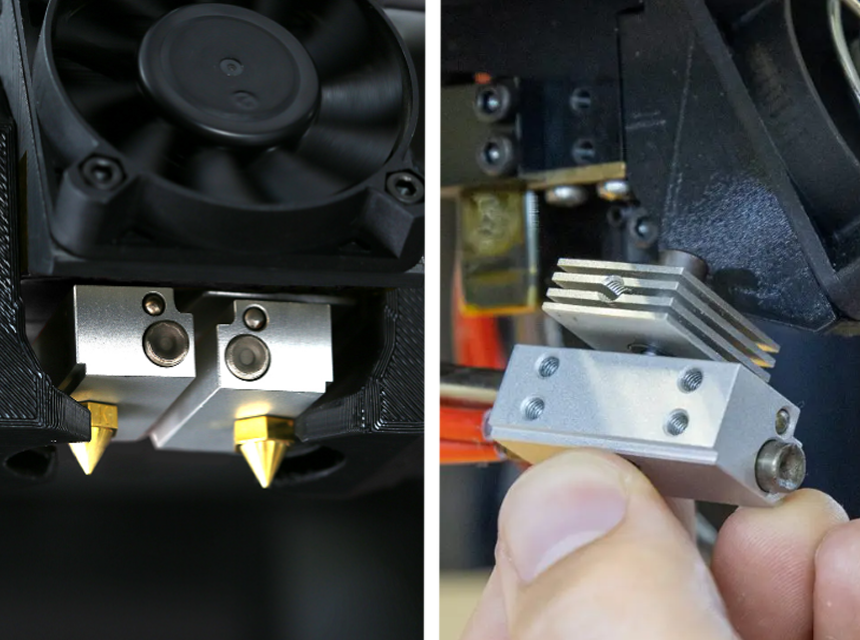
If you are looking to do multi-material 3D printing, choose a printer with a multi-extruder setup. A printer with dual extruders or more will allow you to do multi-color 3D printing or print intricate and complex 3D models with water-soluble PVA supports on the secondary extruder. The only downsides of a multi-extruder setup are a higher price point, high maintenance, and the need for technical expertise due to the system’s complexity. Therefore, a CoreXY 3D printer with multiple extruders only makes sense if you regularly need to do multi-material printing.
Multiple nozzles are also essential for multi-color 3D printing. They simplify the process and can help you prevent the object from collapsing by applying a water-soluble support material to it during printing.
CoreXY 3D printers come in two options; pre-assembled and kits. Pre-assembled models come ready to use straight from the box, and kits require assembly, which can be time-consuming. The beauty of CoreXY 3d Printer kits is that they are more affordable, and you can customize certain aspects to suit your printing needs. Also, assembling the kit allows you to familiarize yourself with the Printer’s parts, so you can easily troubleshoot and fix it later on if it has any issues.
The only challenge with a kit is you need technical expertise to pull it off. As a beginner, do not even think of getting a kit because an improper assembly will give you poor print results. A pre-assembled printer should be your top priority as it comes pre-configured and calibrated from the factory.
As mentioned before, many CoreXY 3D printers use FDM printing technology. Other printing methods include Stereolithography (SLA), Selective Laser Sintering (SLS), and Digital Light Processing (DLP). Of all these methods, FDM is the easiest to master and can produce quick and reliable results. Although it has the lowest resolution, it has high accuracy and is cheaper. CoreXY printers are relatively new FDM printers as they were invented later than Delta, Scara, and Cartesian printers.
When buying a printer, consider its weight and size based on where you intend to place it and if you are going to move it around a lot. If you want a printer that can fit your small desk or workstation, choose a compact printer like the Voron 0.1 and Creality Ender 4. As for weight, choose a model that you can easily move from one point to another without needing an extra hand; the build material determines the overall weight of the machine. Printers made with aluminum are much lighter than those made with alloy.
Assembling a CoreXY 3D printer can be challenging, especially for a beginner without technical expertise. It takes time to assemble the Printer’s frame structure correctly as well as tune the belts for the best results. Luckily, many partially assembled kits are a little easier for beginners to pull off. A good example of a partially assembled CoreXY 3D printer kit is the Creality Ender 6.
CoreXY 3D printers provide top-quality prints at the fastest printing speeds only if their various components and slicer settings are fine-tuned.
Once CoreXY printers are assembled, you can easily control them on their touch screens to create vibrant pieces. Most models come with convenient features like automatic bed leveling, filament run-out detection, and power resume print function. Some models can be difficult to use, especially if they require manual bed leveling.
CoreXY 3D printers are better than their Cartesian counterparts in terms of speed, efficient utilization of print space, and material compatibility. They are a better option if you need fast printing speeds without compromising on print quality.
A CoreXY 3D printer is the best thing you can add to your hobby room. Technology is constantly improving, and the market has become saturated with affordable models. Our product list has the best CoreXY printers that money can buy. Our top pick, the Formbot Voron 2.4 R2 CoreXY 3D Printer Kit, is the best Printer if you are looking for a maximum print size at a fast speed without compromising the quality.
Our second choice, the Vivedino Troodon CoreXY 3D Printer, is the best premium, pre-assembled CoreXY Printer that money can buy. It has lots of convenient features that make it easy to use.
Our third pick, Tronxy X5SA, is the best CoreXY 3D Printer for the money. It offers excellent value for money as it comes with a lot of incredible features and decent build volume at a reasonable price point. It is a perfect choice for hobbyists and students.
